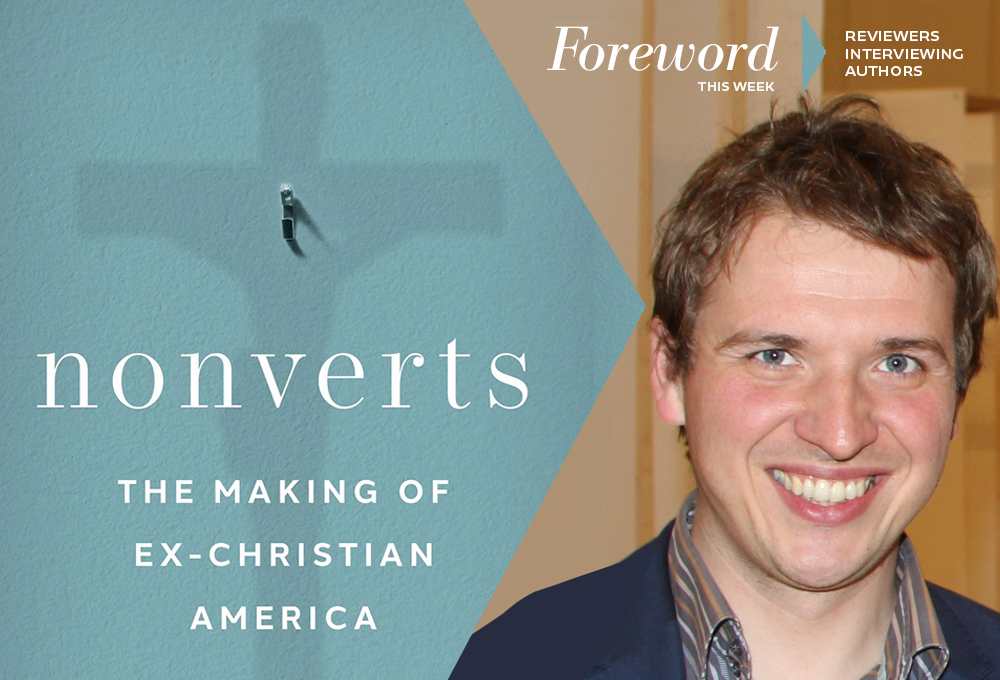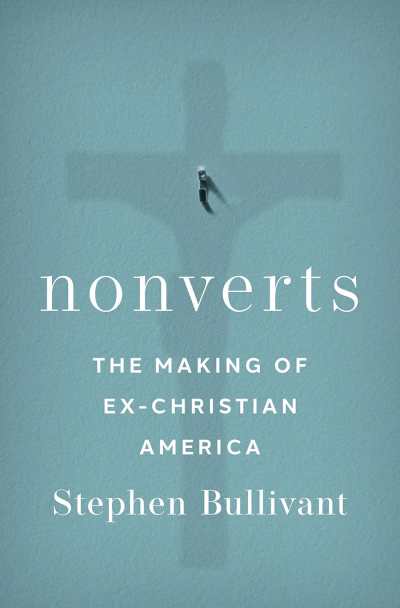It looks like you've stumbled upon a page meant to be read by our code instead of viewed directly. You're probably looking for this page.
Reviewer Rebecca Foster Interviews Stephen Bullivant, Author of Nonverts

From week to week, we strive to use these introductions not as a way to tell you the what of an interview topic but the why. Why it is important. Why it is something that affects you. Why you should care.
But this week, we’re stumped—because it’s all but impossible to know how the United States will change as the majority of its citizens gradually stop believing in God the father, Jesus as savior, heaven and hell, repenting of sins, and other sacred Christian beliefs.
Does Christianity provide a moral compass? If so, will a nonreligious US become more lawless and violent? Does churchgoing strengthen communities and encourage a “love thy neighbor” attitude? If so, will our non-believing society become more segmented and isolated?

Tough questions, to be sure, and no writer is closer to providing plausible answers than this week’s guest, Stephen Bullivant, author of Nonverts: The Making of Ex-Christian America—which earned a flattering review from Rebecca Foster in Foreword’s November/December issue.
Rebecca, see what you can tease out of him.
In Nonverts, you focus, in turn, on Mormonism, Protestantism, Evangelicalism, and Catholicism. Did you know in advance what the structure would be, or did it arise during the writing process?
One of the big ideas of the book is that “the rise of the nones” plays out very differently in different religious or denominational traditions. I’d already told the Catholic-specific story in a previous book, 2019’s Mass Exodus. And so in Nonverts, to properly tell the overarching, national story, I knew I’d have to do some deep dives into different religious subcultures along the way. The basic structure took shape during the course of all the interviewing, often literally while on the road between meetings. I had all this stuff—hours and hours of material that I was desperate to do justice to.
So in gradually processing it all, and getting everything straight in my own head, particular ideas, themes, and patterns began to crystallize. Plus, of course, interviewees tell you things where you just think “that’s definitely going in.” I guess the final process is not a million miles away from “plotting” out a detective novel. Yes, there are certain take-home messages and ideas you want the book as a whole to communicate, but you want to do it while taking the reader on an interesting, enjoyable journey.
The book is enriched by the interviews you and your two research assistants conducted with seventy people. Starting with John the “firearms enthusiast” and Judy the “heavily inked, polyamorous bisexual” in southern Louisiana, you meet a fascinating array of people. How did you go about finding your interviewees, and eliciting the details of their faith journeys?
Lots of ways. Putting word out via friends or colleagues. Online forums or message boards. Often interviewees would suggest other potential interviewees—family members, people they chat to while walking their dog, all sorts. Even in places where nonreligious folks are a bit harder to come by—northern Florida is a good example—they tend to have a “spidey sense” about others who aren’t religious either, even if they’ve never actually spoken about it.
As a general rule, I didn’t go looking for “nones” in what you might think are the most obvious places—atheist societies, humanist groups, etc. Instead, I might put a post up on a generic forum for a particular place, or for a given interest group (“New Yorkers Who Like Beer,” say), explaining who I was, who I was wanting to talk to and why, and asking if any such people would be willing to let me buy them a coffee or beer or whatever at a place of their choosing. That way, you get a much broader, more representative mix of people (plus a lot of “you’re an axe murderer, right?”-type banter). That said, I did find some interviewees on dedicated ex-Mormon forums. Due to numbers, they’re harder to find in the general population (unless you’re in or around Utah), whereas you get plenty of ex-Catholics, ex-Mainliners, and ex-Evangelicals in most places.
Something I should say, though, is that people were very, very willing to go out of their way to talk to me—taking the afternoon off work, postponing holiday plans, everything. When word got out there was some random English dude wanting to talk to ex-religious folks, I’d get deluged with offers—pleas, even—from people eager to help. I hope it comes across in the book just how much I enjoyed doing those interviews.
Broadly speaking, what differences did you see as you traveled in various states?
Well, there’s the obvious ones. It feels much easier and more normal to be nonreligious in somewhere like New York City or Portland, Oregon, than it is in much of Tennessee or Florida or Louisiana. Though that in itself can play out in interesting ways. It tends to mean a lot more to those in more religious places, for example, and they often value close friendships—“a safe space,” as one interviewee called her group of nonreligious moms—with others like them.
More subtly, some of the really striking, surprising differences come about not between states, but within them. I interviewed in both New Orleans and another, smaller city in Louisiana—which I don’t name, as the smaller the place, the easier it might be for someone to be identified—and my interviewees themselves were quick to stress that this was the real Deep South. Likewise, I say that it’s far easier to be nonreligious in NYC, which is generally true. But not in the heavily Mexican and Salvadoran neighborhood where one of the young guys I interviewed—just before he started his early morning bus-driving shift to pay his way through college—grew up.
There’s a fair amount of statistics and graphs in the book. To what extent do you feel that the numbers tell the real story?
Here’s how I like to think of it. Numbers and the like (“quantitative” data, in the jargon) provide us with a skeleton of the phenomenon—the basic shape and structure. But in order to put flesh on the bones—to get any sense of a richly textured, living, breathing reality—you’ve got to go out and really find out about some of those individual experiences that make up those numbers. And when we’re interested in things happening either now or in the recent past (and the whole nonverts phenomenon is both of those things), then traveling round and talking to people, face to face, is really the best way to go about it. I go to some lengths in one of the early chapters to try to help readers make sense of quite what’s behind those “a quarter of Americans are now nones”-type statistics, and what their limits are. They’re useful, even indispensable. But they’re only going to get you so far in understanding what’s going on.
Do you think of the Trump presidency as a particular tipping point?
Not exactly, no. You’d think it might be, but the data I’ve seen doesn’t really bear it out—that is, there doesn’t seem to have been any particular uptick of, say, ex-Evangelical nonversions in the wake of 2016, over and above the already fairly steady rate. What it probably has done, though, is solidify lots of people in the positions they were already in. I spoke to lots of ex-Evangelicals, for example, who had already left long ago, but who saw what you might call “MAGA Christianity” as further confirmation of everything they’ve been saying for years. That said, let’s not forget that Trump was and is very popular with millions of Americans. The close association in many people’s minds between Trump and certain strands of Evangelicalism had probably helped to keep a good number of his fans identifying as Evangelicals who might otherwise have drifted off into being nones.
Will we ever see an atheist president?
Oh, sure we will, although whether they’ll call themselves an atheist is a whole other matter. What I mean by that is that a lot of people who are atheists (i.e., they don’t believe in any God or gods) either don’t like the label itself, or are well aware that others don’t like it. Any non-believing politician will have advisers telling them that “atheist” is a turn-off for voters, so better to go with “seeking” or “spiritual” or “raised as an X,” then pivot to a folksy story about how they value and respect all religious paths. As the nones grow and grow as a proportion of the US population, the trick will be to dog-whistle to that constituency, without doing or saying anything to alienate the still very large numbers of religious voters in either main party.
How do you predict that faith communities in the USA might be changed as a result of Covid-19?
The short- to mid-term effects are already pretty clear. A million deaths, predominantly in some of the more religious demographic groups (e.g., seniors, minorities), have been felt in basically every congregation in the country. Plus a lot of people—including lots of young families—will have gotten out of the habit of churchgoing, and that can be hard to pick up again, even if you half-want to (“we really must start going again, but next Sunday … “). So it’s a pretty significant net loss.
The longer term effects are much harder to judge. Periods of turmoil tend to lead to religious booms—after the Civil War and Second World War are good examples in US history—so maybe something’s brewing in the culture, though I at least haven’t noticed it yet. On the other hand, the biggest single predictor of whether someone grows up to be a religiously practicing adult is how much religious practice they did as a child. Now, there’s a lot more to religious practice than going to church, or synagogue, or mosque—prayers at home, talking about religious topics with your family, etc.—but it’s a big one. And what effect that period of disruption ends up having on a whole generation, we won’t find out until twenty, thirty, forty years from now.
Rebecca Foster